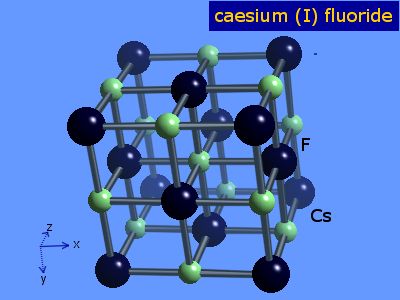Caesium fluoride
- Formula: CsF
- Hill system formula: Cs1F1
- CAS registry number: [13400-13-0]
- Formula weight: 151.904
- Class: fluoride
- Colour: white
- Appearance: crystalline solid
- Melting point: 703°C
- Boiling point: 1231°C
- Density: 4640 kg m-3
The following are some synonyms of caesium fluoride:
- caesium fluoride
- caesium(I) fluoride
- cesium fluoride
- cesium(I) fluoride
The oxidation number of caesium in caesium fluoride is 1.
Synthesis
One way to make caesium fluoride is to react the hydroxide with hydrofluoric acid. The resulting salt can then be purified by recrystallization.
CsOH(aq) + HF(aq) → CsF(aq) + H2O(l)
Another way to make caesium(I) fluoride is to react the carbonate with CsHF2. The resulting salt can then be purified by recrystallization.
Cs2CO3(aq) + 2CsHF2(aq) → 4CsF(aq) + H2O(l) + CO2(g)
While not a normal route of preparation because of the expense, caesium metal reacts vigorously with all the halogens to form caesium halides. So, it burns with fluorine, F2, to form caesium(I) fluoride, CsF.
2Cs(s) + F2(g) → 2CsF(s)
Solid state structure
- Geometry of caesium: 6 coordinate: octahedral
- Prototypical structure: NaCl (rock salt)

Element analysis
The table shows element percentages for CsF (caesium fluoride).
| Element | % |
|---|---|
| Cs | 87.49 |
| F | 12.51 |
Isotope pattern for CsF
The chart below shows the calculated isotope pattern for the formula CsF with the most intense ion set to 100%.
References
The data on these compounds pages are assembled and adapted from the primary literature and several other sources including the following.
- R.T. Sanderson in Chemical Periodicity, Reinhold, New York, USA, 1960.
- N.N. Greenwood and A. Earnshaw in Chemistry of the Elements, 2nd edition, Butterworth, UK, 1997.
- F.A. Cotton, G. Wilkinson, C.A. Murillo, and M. Bochmann, in Advanced Inorganic Chemistry, John Wiley & Sons, 1999.
- A.F. Trotman-Dickenson, (ed.) in Comprehensive Inorganic Chemistry, Pergamon, Oxford, UK, 1973.
- R.W.G. Wyckoff, in Crystal Structures, volume 1, Interscience, John Wiley & Sons, 1963.
- A.R.West in Basic solid state chemistry Chemistry, John Wiley & Sons, 1999.
- A.F. Wells in Structural inorganic chemistry, 4th edition, Oxford, UK, 1975.
- J.D.H. Donnay, (ed.) in Crystal data determinative tables, ACA monograph number 5, American Crystallographic Association, USA, 1963.
- D.R. Lide, (ed.) in Chemical Rubber Company handbook of chemistry and physics, CRC Press, Boca Raton, Florida, USA, 77th edition, 1996.
- J.W. Mellor in A comprehensive treatise on inorganic and theoretical chemistry, volumes 1-16, Longmans, London, UK, 1922-1937.
- J.E. Macintyre (ed.) in Dictionary of inorganic compounds, volumes 1-3, Chapman & Hall, London, UK, 1992.
